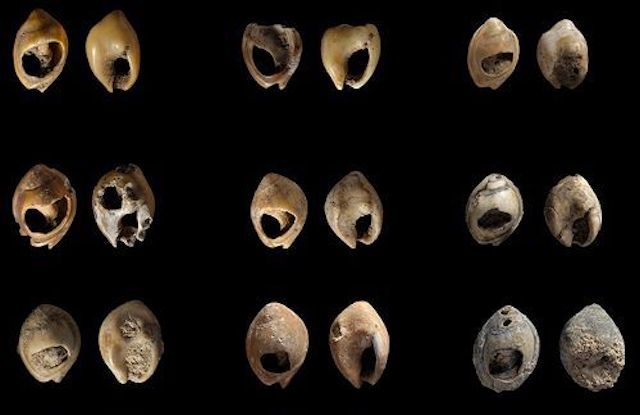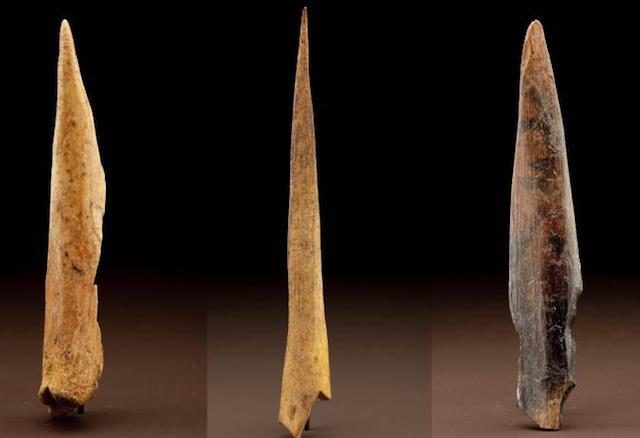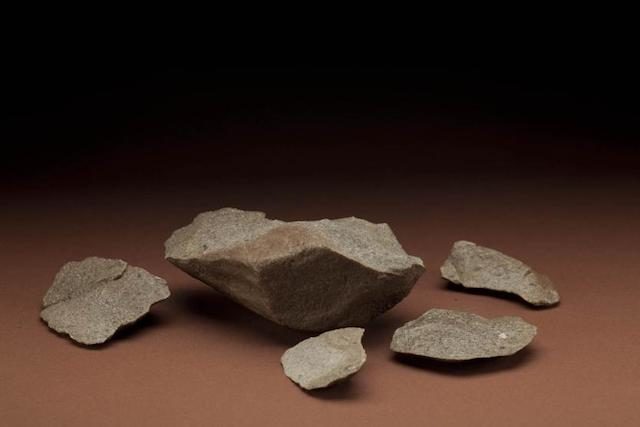Whenever something incredibly ancient and incredibly cool turns up, there’s always someone on hand to shout that it’s evidence of aliens. Awesome as it would be to know ET was hanging out here in 10,000 B.C. (or whenever), the truth is both much simpler and much more interesting. See, you don’t need aliens to explain away intricate ancient objects. We humans have been capable of creating incredible stuff since before there were even humans.
The following objects are all man made in the sense that ‘a proto-human intelligence was responsible for their creation’. But not all of them came from the mind of homo sapiens. Instead, some come courtesy of our distant ancestors, the thinking apes who preceded us and helped us on our journey. Think the prehistoric world is dull? Think again.
10. Ice Age “Batons” (Approx. 28,000 years old)

Yes, we know what you’re thinking. Something along the lines of: “Gee, these ice age batons sure look like a certain part of the male anatomy.” So before we go any further, let us just categorically state that, yes, these batons do indeed look like a bunch of comedy-sized wangs. And there’s a good reason for that. Wanna guess what it is? That’s right, far from being immature, you’ve hit on what these probably were. You’re looking at an image of a stone age sex toy.
Known euphemistically as ‘batons’, these proto-Ann Summers toys have been found in a number of Ice Age sites, no doubt leading to many awkward conversations among archeologists. The oldest of all is from Germany, specifically a place known as Hohle Fels Cave. Now, pay attention, because you’re gonna be hearing that name again and again in this article. Hohle Fels contains one of our best-preserved collections of Ice Age artifacts anywhere in the world. In 2003, it also turned out to contain the oldest baton yet found. The one you see above dates from around 28,000-30,000 B.C.
Just think about that, for a second. This ancient – ahem – toy is older than Stonehenge, Machu Picchu and yo momma combined. Not that it was all dirty. According to those who found it, the tool was also used for “knapping flints” (whatever the heck that is).
9. Animal Figurines (30,000-40,000 years old)

Sometimes, the world just likes to drop something incredible in our laps, presumably just for the fun of watching us collectively freak out. The ancient figurines found at Hohle Fels (that place again) are one of those somethings. Among the oldest sculptures ever found, they depict miniture birds, horses’ heads, and half-animal humans in jaw-dropping detail. Did we mention the detail? When they were made public, in late 2003, archeology expert Dr Anthony Sinclair declared: “They are as good as anything you will see thousands of years later – from 3-4,000 BC.” Suck it, Ancient Greece.
But even these works of genius have nothing on the oldest figurine we’ve yet found. Discovered in the same cave of wonders as the figurines was the Venus of Hohle Fels. A tiny carving of a woman, the Venus may also be the earliest extant work of erotica. The carving has improbably large breasts, a big backside, and exaggerated genitals. She’s also a lot fatter than we’re guessing any Ice Age human ever was, unless there’s a prehistoric McDonalds waiting to be found in Hohle Fels somewhere. This suggests she may have been a fantasy, an example of Ice Age man’s longing for a well-stacked, fleshy woman. Nice to see some things never change.
8. Neanderthal Cave Art (40,800 years ago)

Yeah, Neanderthals aren’t human. Well, get used to it. We’re gonna be leaving homo sapiens for good in a little while to go gallivanting around the world of Homo erectus and all his extinct pals. But first, let’s just pause and take a breather, and admire the view of one of the oldest expressions of abstract art ever found. Discovered in a Spanish cave in 2012, this image dates back a staggering 40,800 years in time.
Imagine the incredible amount of time that exists between you and Julius Caesar or Jesus Christ. Now times that unimaginable distance by ten. Now double it, and then give up and throw the whole concept of picturing this away, because you’re never gonna be able to really grasp just how stupidly long ago this was. Back then, ‘popping out for a bite’ meant stepping outside and being swallowed by a sabretooth tiger. It was a world so unimaginably different from ours as to be… well, unimaginable. Yet the not-quite-humans who inhabited this space still felt moved to do something uniquely human. They created art, using the only things they had: their hands and some plant pigment. And we think that’s just swell.
7. Ancient Flutes (42,000 years old)

The Aurignacian culture is the coolest thing you’ve probably never heard of. A bunch of early humans who started doing their thing in the Upper Paleolithic era, the Aurignacians mark the point where art and music and specialized tools began to emerge. So, yeah, pretty much everything you take for granted today started here. At one point, scientists thought this period of intense change started no earlier than 40,000 years ago. Then someone stumbled across a 42,000 year old bone flute in yet another German cave and the dates had to be revised upwards.
If the thought of an ancient flute doesn’t send a chill down your spine, you may want to quickly double check and make sure you’re not in traction. These finds mean the earliest European humans were creating music from almost the moment they arrived on the continent. Just imagine. It’s dark. You’ve just come back from a long day’s woolly mammoth punching, or whatever the heck Stone Age man used to do. The only light in your cave is from the flickering of the fire. You sit around, staring into its shifting flames. And then, slowly, someone pulls out a flute and starts to play…
See what we mean? Magical. This is the dawn of human emotion we’re witnessing here, and we’ve still got well over a million years of history left to go.
6. Aterian Beads (110,000 years old)

Grotte des Pigeons is a cave in Eastern Morocco that for ages wanted nothing more than for people to forget it had such a stupid name. Then, sometime in the mid-20th Century, some archeology guys came along and decided, hey, this looks like a pretty good spot to dig. So they dug and they dug and they dug until suddenly everyone was too busy exclaiming over all the crazy awesomeness in Grotte des Pigeons to concentrate on its stupid name. There were ashes and tools and carved rocks and all sorts of treasures. But the biggest treasure of all may have been the beads.
Made of shells with perforated holes, some still with traces of red ochre on them, the beads were likely the earliest examples of jewelry we have. The researchers dated them to an impossibly-distant 110,000 years ago, a time when the wheel was a far-off dream, and the concept of agriculture was like witchcraft. Yet our ancestors were still making jewelry. Even in a world of unrelenting danger, bear attacks and lifespans of under 30 years, we still just wanted to look good. We can’t tell if that’s shameful or the coolest thing ever.
5. Bone Awls (200,000-400,000 years old)

OK, from here on in, the dates get vague and the periods of time involved become utterly incomprehensible. If you’re cool with that then stick with us, because this is also where we’re gonna find the coolest stuff. For this entry, that means bone awls. A feature of the Middle Stone Age (MSA), bone awls were little sharpened bits of bone, probably used for piercing holes in hide and making clothes. As such, they show our ancestors moving on from just wrapping themselves in the skin of a dead zebra to actually creating their own garments.
Like most of the stuff in the MSA, bone awls were likely invented in Africa and then taken to Europe along with the first early humans. Good job, too, as Europe back then was likely freezing. Honestly, we complain if we get stuck without heating for half a day during a mild winter. Imagine having to huddle round a fire in a cave for warmth AND design your own clothes using only sharpened bits of bone and the flesh of whatever you’d killed. There are residents of Jersey Shore who live more-fulfilling lives than that (kidding. No they don’t).
4. Projectile Points (200,000-400,000 years old)

This is where the MSA really hit its stride. Before early humans perfected projectile points, killing an animal meant charging at it with a kamikaze yell, waving an axe above your head and hoping it didn’t eat you (it frequently did). With the advent of sharpened projectile points, the equation changed dramatically. Now you didn’t have to get within eating-distance to kill your dinner. Humanity’s time at the top of the food chain had survived.
Stop and think about this for a second, about all the stuff we take for granted. Before projectile points were invented, the only time you got to eat a fast moving animal like a bird was when it dropped dead of kidney failure right in front of you. Suddenly having spears and arrows allowed humans to expand their diets. It allowed them to create small stockpiles of food and defend themselves from a distance. Some have even suggested formulating complicated hunting plans using these tools helped us develop modern human intelligence.
Of course, our ancestors did plenty of hunting before the invention of spears and arrows. But, still. Their coming was a gamechanger that reorganized our entire species.
3. Hand Axe (1.76m years old)

Long before the Aurignacian came along with their music and painting and liberal hippy art stuff, the hottest culture in human history was the Acheulian. Occurring sometime around 1.76 million years ago, this stone age revolution saw our ancestors discard the simplistic tools they’d been using up until then, and start crafting complex weapons unlike anything ever seen before. Stones with specially-sharpened ends that were wielded by hand, these ‘hand axes’ saw early humans able to easily kill other animals for the first time in history.
For a long time, scientists thought the Acheulian revolution started around 1.4 million years ago, the period a number of hand axes found in Ethiopia dated from. Then 2011 came along and turned all that on its head. That was the year that archeologists digging on the muddy banks of Lake Turkana in Kenya uncovered hand axes dating from 1.76 million years ago. That’s a difference of 360,000 years; equivalent to the distance in time between you reading this on your tablet and our ancestors’ creation of stone projectile points.
Those who created and used these hand axes, by the way, definitely weren’t human. They were probably Homo Erectus, the guys who decided walking on two legs was the way to go.
2. Oldowan Tools (Around 2.5m years ago)

Unlike the hand axes of the Acheulian revolution, no non-experts today would be able to recognize Oldowan Tools as even being tools. They were pebbles and rocks that had been crudely chipped to give one serrated edge, likely for cutting, chopping and scraping. We’re talking the absolute most basic of basic implements, here. This was the dawn of the Paleolithic era, the point in time when hominids realized you could get more done with implements than you could with your teeth. It sounds simple to us now, but back then no-one had ever even thought of it. How could they? They were little more than apes at this point.
Despite the mind-blowing chasms of time between us and the first Oldowan tools, they’ve been found all over the world. At least, all over the world as it would have been back then, which basically means ‘Africa’. At this point, Europe and Asia were as alien to these tool makers as planet Weezigg-Cloop is to you (we’re gonna discover it in about 4,000 years. It’s gonna be awesome).
Interestingly, some scholars think those using these tools may have been vegetarian, hence their being content with not developing better tools for like 700,000 years. Who needs an animal-killing hand axe when you don’t eat animals?
1. Contents of the Lake Turkana Toolbox (3.3m years old)

And then we have the Lake Turkana Toolbox.
To be clear, the Lake Turkana Toolbox shouldn’t exist. Digging it up and dating it to 3.3m years ago is like opening Tutankhamun’s Tomb to find a Boeing 747 inside. In fact, scratch that. The distance of time is so vast that it would be like opening Tutankhamun’s Tomb to find a Sci-fi device that won’t be invented for another 796,000 years. One that does stuff we in backward old 2017 can’t even imagine. 3.3m years ago is meant to be a time when no species existed that was capable of making tools. And yet, in 2015, scientists discovered that this was exactly what the apes hanging around Lake Turkana had been doing.
To be sure, they don’t look like tools. They look like sharp rocks. But, like the Oldowan Tools above, the point is that someone – or something – made them sharp. Whatever that pre-human creature was, it was starting Earth’s sentient species down a path that would eventually lead to hand axes, then projectile points, then beads, then art, then music, then sculpture… and so-on right the way up to the tablets and spacecraft and 3D printers of today. When you look at it like that, you gotta admit these dull old rocks are secretly kinda cool.
4 Comments
not a fan of comedic stylings or popup telling me i will be smaterer reading this list aggregation site
Neanderthals were human btw.
I disagree with carlo^^. I do not like your writing style. While I find the whole post fascinating, it could do better with less youtube vernacular. Great information though.
i love your writing style bro, I am a daily reader of toptenz from the Philippines!